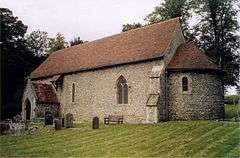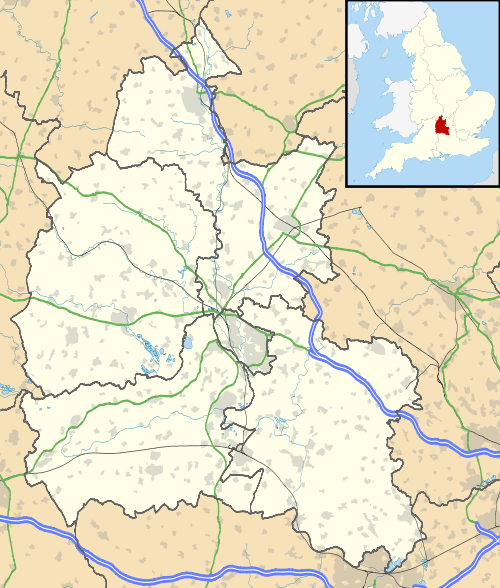Swyncombe
Swyncombe is a hamlet and large civil parish in the high Chilterns, within the Area of Outstanding Natural Beauty about 4 1⁄2 miles (7 km) east of Wallingford, Oxfordshire, England. Swyncombe hamlet consists almost entirely of its Church of England parish church of Saint Botolph, the former rectory and Swyncombe House.[1] The population of the parish is in the hamlets of Cookley Green and Russell's Water, and the scattered hamlet of Park Corner. The 2011 Census recorded the parish's population as 250.[2] It is partially forested and is the fifth largest of 87 civil parishes in the District.
| Swyncombe | |
|---|---|
 St Botolph's parish church | |
 Swyncombe Location within Oxfordshire | |
| Area | 14.39 km2 (5.56 sq mi) |
| Population | 250 (2011 Census) |
| • Density | 17/km2 (44/sq mi) |
| OS grid reference | SU6890 |
| Civil parish |
|
| District | |
| Shire county | |
| Region | |
| Country | England |
| Sovereign state | United Kingdom |
| Post town | Henley-on-Thames |
| Postcode district | RG9 |
| Dialling code | 01491 |
| Police | Thames Valley |
| Fire | Oxfordshire |
| Ambulance | South Central |
| UK Parliament | |
| Website | Swyncombe Parish Council |
Manor
Swyncombe's toponym is derived from the Old English words Swin for wild boar and combe for valley or hollow.
After the Norman conquest of England the manor of Swyncombe was granted to the Norman Miles Crispin, the first castellan of Wallingford Castle. The Domesday Book records that by 1086 he had granted it to Gilbert Crispin,[3] a monk who in 1085 was made Abbot of Westminster.
The Jacobethan manor, Swyncombe House, was built in 1840 to replace an early 16th-century manor house. The rectory was built in a neoclassical style in 1803 by Daniel Harris,[1] who at the time was governor of Oxford Castle and also practised as a building contractor, engineer and architect.[4]
Parish church
St Botolph's parish church was originally early Norman. The Gothic Revival architect Benjamin Ferrey heavily restored the building in 1850. The font possibly predates the building, but its cover and the rood screen with loft date from early in the 20th century. In the 19th century restoration, medieval wall paintings were found and repainted.[1] St Botolph's is a Grade II* listed building.[5]
St Botolph's parish is now part of the Benefice of Icknield, along with the parishes of Britwell Salome, Pyrton and Watlington.[6]
References
- Sherwood & Pevsner 1974, p. 801.
- "Area: Swyncombe CP (Parish): Key Figures for 2011 Census: Key Statistics". Neighbourhood Statistics. Office for National Statistics. Retrieved 22 August 2015.
- Keats-Rohan 1989, p. 311.
- Davies & Robinson 2001, p. 43.
- Historic England. "Church of St Botolph (Grade II*) (1180499)". National Heritage List for England. Retrieved 22 August 2015.
- Archbishops' Council. "Benefice of Icknield". A Church Near You. Church of England. Archived from the original on 4 March 2016. Retrieved 22 August 2015.
Sources
- Davies, Mark; Robinson, Catherine (2001). A Towpath Walk in Oxford. Oxford: Towpath Press. p. 43. ISBN 0-9535593-1-9.CS1 maint: ref=harv (link)
- Keats-Rohan, MSB (1989). "The Devolution of the Honour of Wallingford, 1066–1148*" (PDF). Oxoniensia. Oxfordshire Architectural and Historical Society. LXXV: 311–318. ISSN 0308-5562.CS1 maint: ref=harv (link)
- Sherwood, Jennifer; Pevsner, Nikolaus (1974). Oxfordshire. The Buildings of England. Harmondsworth: Penguin Books. p. 801. ISBN 0-14-071045-0.CS1 maint: ref=harv (link)
